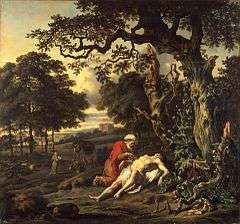Luke 10
| Luke 10 | |
|---|---|
.jpg) Luke 6:4-16 on Papyrus 4, written about AD 150-175. | |
| Book | Gospel of Luke |
| Bible part | New Testament |
| Order in the Bible part | 3 |
| Category | Gospel |
Luke 10 is the tenth chapter of the Gospel of Luke in the New Testament of the Christian Bible. It records the sending of seventy disciples by Jesus, the famous parable about the Good Samaritan, and his visit to the house of Mary and Martha.[1] The book containing this chapter is anonymous, but early Christian tradition uniformly affirmed that Luke composed this Gospel as well as Acts.[2]
Text
- The original text is written in Koine Greek.
- Some most ancient manuscripts containing this chapter are:
- Papyrus 75 (written about AD 175-225)
- Papyrus 45 (c. 250)
- Codex Vaticanus (325-350)
- Codex Sinaiticus (330-360)
- Codex Bezae (c. 400)
- Codex Washingtonianus (c. 400)
- Codex Alexandrinus (c. 400-440)
- Codex Ephraemi Rescriptus (c. 450)
- This chapter is divided into 42 verses.
Structure
The New King James Version organises this chapter as follows (with cross references to parallel sections in the other gospels):
- Luke 10:1-12 = The Seventy Sent Out (Matthew 8:19-22)
- Luke 10:13-16 = Woe to the Impenitent Cities (Matthew 11:20-24)
- Luke 10:17-20 = The Seventy Return with Joy
- Luke 10:21-24 = Jesus Rejoices in the Spirit (Matthew 11:25-27; Matthew 13:16-17)
- Luke 10:25-37 = The Parable of the Good Samaritan
- Luke 10:38-42 = Mary and Martha Worship and Serve
Narrative of the Seventy
Theologian Heinrich Meyer calls this section the "Narrative of the Seventy" and links it to the earlier account of the sending out of advance messengers in Luke 9:52.[3]
The Parable of the Good Samaritan

This parable is recounted only in this chapter of the New Testament. A lawyer or 'expert in the law' asked Jesus to explain who his 'neighbour' is, referring to the ordinance of Leviticus 19:18:
- You shall not take vengeance, nor bear any grudge against the children of your people, but you shall love your neighbor as yourself.[4]
In response, Jesus told a story of a traveller (who may or may not have been a Jew [5]) who is beaten, robbed, and left half dead along the road. First a priest and then a Levite come by, but both avoid the man. Finally, a Samaritan comes by. Samaritans and Jews generally despised each other, but the Samaritan helps the injured man.
Portraying a Samaritan in a positive light would have come as a shock to Jesus's audience.[6] Some Christians, such as Augustine and John Newton,[7] have interpreted the parable allegorically, with the Samaritan representing Jesus Christ, who saves the sinful soul.[8] Others, however, discount this allegory as unrelated to the parable's original meaning,[8] and see the parable as exemplifying the ethics of Jesus.[9]
The parable has inspired painting, sculpture, poetry and film. The colloquial phrase "good Samaritan", meaning someone who helps a stranger, derives from this parable, and many hospitals and charitable organizations are named after the Good Samaritan.
Mary and Martha
In Luke's account, the home of Martha and Mary is located in 'a certain village'.[10] Bethany is not mentioned and would not fit with the topography of Jesus' journey to Jerusalem, which at this point in the narrative is just commencing as he leaves Galilee. John J. Kilgallen suggests that "Luke has displaced the story of Martha and Mary".[11]
See also
- Bethany
- Lucifer
- Martha
- Mary of Bethany
- Ministry of Jesus
- Miracles of Jesus
- Other related Bible parts: Isaiah 14; Matthew 8, 11, 13, 22;
References
- ↑ Halley, Henry H. Halley's Bible Handbook: an Abbreviated Bible Commentary. 23rd edition. Zondervan Publishing House. 1962.
- ↑ Holman Illustrated Bible Handbook. Holman Bible Publishers, Nashville, Tennessee. 2012.
- ↑ Meyer, H. (1873), Meyer's NT Commmentary on Luke 10, accessed 12 June 2012
- ↑ Leviticus 19:18
- ↑ Joel B. Green, The Gospel of Luke, Eerdmans, 1997, ISBN 0-8028-2315-7, p. 429.
- ↑ Funk, Robert W., Roy W. Hoover, and the Jesus Seminar. The five gospels. HarperSanFrancisco. 1993. "Luke" p. 271-400
- ↑ Newton, J., The Good Samaritan, accessed 13 June 2018
- 1 2 Caird, G. B. (1980). The Language and Imagery of the Bible. Duckworth. p. 165.
- ↑ Sanders, E. P., The Historical Figure of Jesus. Penguin, 1993. p. 6.
- ↑ Luke 10:38
- ↑ Kilgallen, J. J., Martha and Mary: Why at Luke 10,38?, Biblica, Vol. 84, No. 4 (2003), pp. 554-561
External links
| Preceded by Luke 9 |
Chapters of the Bible Gospel of Luke |
Succeeded by Luke 11 |